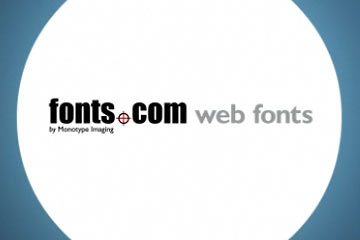Letter-perfect
 Web designers are constantly frustrated by how limited we are in terms of the typefaces (fonts) we can use. It's not nearly as easy as it is in the world of print.
Web designers are constantly frustrated by how limited we are in terms of the typefaces (fonts) we can use. It's not nearly as easy as it is in the world of print.
If you've ever written a letter in Microsoft Word or any other program you know that you have a menu of dozens, maybe hundreds of fonts to choose from. You can pick the exact look and style that suits your message.
We'd like to do the same on our web pages but there's a slight hitch...
Not everyone has the same list of fonts on his/her computer. I may have hundreds of choices on mine while you may have only fifty. And guess what? Yours and mine may not even match for those fifty. If I specify a font that looks like this you may see This. Or possibly This.
You can see the problem.
There are a couple of solutions, and until recently most designers opted for the simplest: use the handful of fonts that are installed on nearly everyone's computers. The list isn't long, maybe fifteen or so fonts that you can count on showing up on Mac, Windows and LInux-based computers. This works, but it's kind of boring. There's only so much Arial and Times Roman that you can stand. More importantly, fonts create a mood, a personality, and sometimes you need that to be different.
A possible solution
I've begun experimenting with Webfonts from Fonts.com, a way of specifying a specific font (or multiple fonts) that doesn't require people to have the font(s) installed on their computers. You set up a project on the Fonts.com website, it generates a single line of code that you paste into your web page, and you're good to go.
Essentially what happens is the code you added tells each person's web browser to download the fonts needed from Fonts.com. It's pretty simple for the designer, and the visitor to your site doesn't do anything at all. The fonts you specified magically appear as needed.
There are a few drawbacks:
- Setting up a project is a bit cumbersome at first. The Fonts.com website needs a few usability improvements.
- A free account is a great deal, but has limitations. You choose from a list of 3000 fonts vs. 8000 for a paid subscription ($10/mo. or $100/mo.). With the free plan you also can have no more than 25,000 pageviews per month, vs. 250,000 or 2,500,000 with the paid plans.
- You may see a brief but visible delay when your site first appears in the browser, before the fonts are downloaded. You may notice them "snap into place". How serious this is varies depending on your internet connection and other factors beyond your control.
The bottom line
So far, so good.
Using Webfonts is easier than another approach called Cufon (which you can see in use for the headlines on my Grand Canyon website.)
Since Fonts.com is part of the big type foundry Monotype, you have access to a lot more fonts than with a similar service called TypeKit. A lot more, and the list includes designers' favorites from Linotype and ITC as well as the Monotype library.
The visual delay is a glitch I wish didn't exist, but it also happens using Cufon and in fact is an issue with external CSS stylesheets as well.
That's my view. How about yours? If you've used TypeKit, Cufon and/or Webfonts, what do you think? Click "![]() Comments" below to share.
Comments" below to share.
